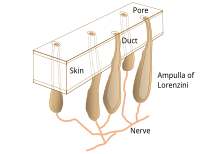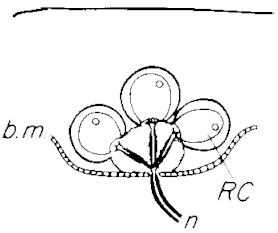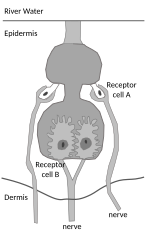Electroreception and electrogenesis

Electroreceptionandelectrogenesisare the closely related biological abilities to perceiveelectricalstimuli and to generateelectric fields.Both are used to locate prey; stronger electric discharges are used in a few groups of fishes (most famously theelectric eel,which is not actually aneelbut aknifefish) to stun prey. The capabilities are found almost exclusively in aquatic or amphibious animals, since water is a much betterconductorof electricity than air. In passive electrolocation, objects such as prey are detected by sensing the electric fields they create. In active electrolocation, fish generate a weak electric field and sense the different distortions of that field created by objects that conduct or resist electricity. Active electrolocation is practised by two groups of weaklyelectric fish,theGymnotiformes(knifefishes) and theMormyridae(elephantfishes), and byGymnarchusniloticus,the African knifefish. An electric fish generates an electric field using anelectric organ,modifiedfrom muscles in its tail. The field is called weak if it is only enough to detect prey, and strong if it is powerful enough to stun or kill. The field may be in brief pulses, as in the elephantfishes, or a continuous wave, as in the knifefishes. Some strongly electric fish, such as theelectric eel,locate prey by generating a weak electric field, and then discharge their electric organs strongly to stun the prey; other strongly electric fish, such as theelectric ray,electrolocate passively. Thestargazersare unique in being strongly electric but not using electrolocation.
The electroreceptiveampullae of Lorenzinievolved early in the history of the vertebrates; they are found in bothcartilaginous fishessuch assharks,and inbony fishessuch ascoelacanthsandsturgeons,and must therefore be ancient. Most bony fishes have secondarily lost their ampullae of Lorenzini, but other non-homologouselectroreceptors have repeatedly evolved, including in two groups ofmammals,themonotremes(platypusandechidnas) and thecetaceans(Guiana dolphin).
History[edit]

In 1678, while doing dissections of sharks, the Italian physicianStefano Lorenzinidiscovered organs on their heads now called ampullae of Lorenzini. He published his findings inOsservazioni intorno alle torpedini.[3]The electroreceptive function of these organs was established by R. W. Murray in 1960.[4][5]
In 1921, the German anatomist Viktor Franz described theknollenorgans(tuberous organs) in the skin of theelephantfishes,again without knowledge of their function as electroreceptors.[6]
In 1949, the Ukrainian-British zoologistHans Lissmannnoticed that theAfrican knife fish (Gymnarchus niloticus)was able to swim backwards at the same speed and with the same dexterity around obstacles as when it swam forwards, avoiding collisions. He demonstrated in 1950 that the fish was producing a variable electric field, and that the fish reacted to any change in the electric field around it.[2][7]
Electrolocation[edit]
Electroreceptive animals use the sense to locate objects around them. This is important inecological nicheswhere the animal cannot depend on vision: for example in caves, in murky water, and at night. Electrolocation can be passive, sensing electric fields such as those generated by the muscle movements of buried prey, or active, the electrogenic predator generating a weak electric field to allow it to distinguish between conducting and non-conducting objects in its vicinity.[9]
Passive electrolocation[edit]
In passive electrolocation, the animal senses the weakbioelectric fieldsgenerated by other animals and uses it to locate them. These electric fields are generated by all animals due to the activity of their nerves and muscles. A second source of electric fields in fish is theion pumpassociated withosmoregulationat thegillmembrane. This field is modulated by the opening and closing of the mouth and gill slits.[10][11] Passive electroreception usually relies upon ampullary receptors such as ampullae of Lorenzini which are sensitive to low frequency stimuli, below 50 Hz. These receptors have a jelly-filled canal leading from the sensory receptors to the skin surface.[8][9]
Active electrolocation[edit]
In active electrolocation,[12]the animal senses its surrounding environment by generating weakelectric fields(electrogenesis) and detecting distortions in these fields using electroreceptor organs. This electric field is generated by means of a specialisedelectric organconsisting of modified muscle or nerves.[13]Animals that use active electroreception include theweakly electric fish,which either generate small electrical pulses (termed "pulse-type" ), as in the Mormyridae, or produce a quasi-sinusoidaldischarge from the electric organ (termed "wave-type" ), as in the Gymnotidae.[14]
Many of these fish, such asGymnarchusandApteronotus,keep their body rather rigid, swimming forwards or backwards with equal facility by undulatingfinsthat extend most of the length of their bodies. Swimming backwards may help them to search for and assess prey using electrosensory cues. Experiments by Lannoo and Lannoo in 1993 support Lissmann's proposal that this style of swimming with a straight back works effectively given the constraints of active electrolocation.Apteronotuscan select and catch largerDaphniawater fleas among smaller ones, and they do not discriminate against artificially-darkened water fleas, in both cases with or without light.[7][15]
These fish create a potential usually smaller than onevolt(1 V). Weakly electric fish can discriminate between objects with differentresistanceandcapacitancevalues, which may help in identifying objects. Active electroreception typically has a range of about one body length, though objects with anelectrical impedancesimilar to that of the surrounding water are nearly undetectable.[12][13][14]
Active electrolocation relies upon tuberous electroreceptors which are sensitive to high frequency (20-20,000Hz) stimuli. These receptors have a loose plug ofepithelialcells whichcapacitivelycouples the sensory receptor cells to the external environment.Elephantfish(Mormyridae) from Africa have tuberous electroreceptors known asKnollenorgansand Mormyromasts in their skin.[16][17][18]
Elephantfish emit short pulses to locate their prey.Capacitativeandresistiveobjects affect the electric field differently, enabling the fish to locate objects of different types within a distance of about a body length. Resistive objects increase the amplitude of the pulse; capacitative objects introduce distortions.[1]
-
Electrolocation of capacitative and resistive objects in elephantfish. The fish emits brief pulses from its electric organ; its electroreceptors detect signals modified by the electrical properties of the objects around it.[1]
-
For theelephantfish,the electric organ in the tail (blue) generates anelectric field(cyan). This is sensed by electroreceptors in the skin, including two electric pits (foveas) to actively search and inspect objects. Shown are the field distortions created by two different types of objects: a plant that conducts better than water (green) and a non-conducting stone (brown).[19]
TheGymnotiformes,including theglass knifefish(Sternopygidae) and theelectric eel(Gymnotidae), differ from the Mormyridae in emitting a continuous wave, approximating a sine wave, from their electric organ. As in the Mormyridae, the generated electric field enables them to discriminate accurately between capacitative and resistive objects.[1]

Electrolocation of capacitative and resistive objects in glass knifefish. |

Theelectric eel'selectric organsoccupy much of its body. |
Electrocommunication[edit]

Weakly electric fish can communicate by modulating the electricalwaveformthey generate. They may use this to attract mates and in territorial displays.[21]Electric catfish frequently use their electric discharges to ward off other species from their shelter sites, whereas with their own species they have ritualized fights with open-mouth displays and sometimes bites, but rarely use electric organ discharges.[22]
When two glass knifefishes (Sternopygidae) come close together, both individuals shift their discharge frequencies in ajamming avoidance response.[13]
In bluntnose knifefishes,Brachyhypopomus,the electric discharge pattern is similar to the low voltage electrolocative discharge of theelectric eel,Electrophorus.This is hypothesized to beBatesian mimicryof the powerfully-protected electric eel.[20]Brachyhypopomusmales produce a continuous electric "hum" to attract females; this consumes 11–22% of their total energy budget, whereas female electrocommunication consumes only 3%. Large males produced signals of larger amplitude, and these are preferred by the females. The cost to males is reduced by acircadian rhythm,with more activity coinciding with night-time courtship and spawning, and less at other times.[23]
Fish that prey on electrolocating fish may "eavesdrop"[24]on the discharges of their prey to detect them. The electroreceptiveAfrican sharptooth catfish(Clarias gariepinus) may hunt the weakly electric mormyrid,Marcuseniusmacrolepidotusin this way.[25]This has driven the prey, in anevolutionary arms race,to develop more complex or higher frequency signals that are harder to detect.[26]
Some shark embryos and pups "freeze" when they detect the characteristic electric signal of their predators.[10]
Evolution and taxonomic distribution[edit]
Invertebrates,passive electroreception is anancestral trait,meaning that it was present in their last common ancestor.[27]The ancestral mechanism is called ampullary electroreception, from the name of the receptive organs involved,ampullae of Lorenzini.These evolved from the mechanical sensors of thelateral line,and exist incartilaginous fishes(sharks,rays,andchimaeras),lungfishes,bichirs,coelacanths,sturgeons,paddlefishes,aquaticsalamanders,andcaecilians.Ampullae of Lorenzini appear to have been lost early in theevolutionof bony fishes andtetrapods,though the evidence for absence in many groups is incomplete and unsatisfactory.[27]Where electroreception does occur in these groups, it has secondarily been acquired in evolution, using organs other than and nothomologouswith ampullae of Lorenzini.[8][27]
Electric organs have evolved at least eight separate times, each one forming aclade:twice during the evolution of cartilaginous fishes, creating the electric skates and rays, and six times during the evolution of the bony fishes.[28]Passively-electrolocating groups, including those that move their heads to direct their electroreceptors, are shown without symbols. Non-electrolocating species are not shown.[27]Actively electrolocating fish are marked with a small yellow lightning flash![]() and their characteristic discharge waveforms.[29]Fish able to deliver electric shocksare marked with a red lightning flash
and their characteristic discharge waveforms.[29]Fish able to deliver electric shocksare marked with a red lightning flash![]() .[27]
.[27]
| Vertebrates |
| |||||||||||||||||||||||||||||||||||||||||||||||||||||||||||||||||||||||||||||||||||||||||||||||||||||||||||||||
Cartilaginous fish[edit]
Sharks and rays (Elasmobranchii) rely on electrolocation using their ampullae of Lorenzini in the final stages of their attacks, as can be demonstrated by the robust feeding response elicited by electric fields similar to those of their prey. Sharks are the most electrically sensitive animals known, responding todirect currentfields as low as 5 nV/cm.[30][31][32][33]
Bony fish[edit]
Two groups ofteleostfishes are weakly electric and actively electroreceptive: the Neotropical knifefishes (Gymnotiformes) and the African elephantfishes (Notopteroidei), enabling them to navigate and find food in turbid water.[34]The Gymnotiformes include theelectric eel,which besides the group's use of low-voltage electrolocation, is able to generate high voltage electric shocks to stun its prey. Such powerful electrogenesis makes use of largeelectric organsmodified from muscles. These consist of a stack of electrocytes, each capable of generating a small voltage; the voltages are effectively added together (in series) to provide a powerful electric organ discharge.[35][36]
Monotremes[edit]

Themonotremes,including the semi-aquaticplatypusand the terrestrial echidnas, are one of the only groups of mammals that have evolved electroreception. While the electroreceptors in fish andamphibiansevolved from mechanosensory lateral line organs, those of monotremes are based on cutaneous glands innervated bytrigeminal nerves.The electroreceptors of monotremes consist of free nerve endings located in themucous glandsof thesnout.Among the monotremes, theplatypus(Ornithorhynchus anatinus) has the most acute electric sense.[37][38]The platypus localises its prey using almost 40,000 electroreceptors arranged in front-to-back stripes along the bill.[34]The arrangement is highly directional, being most sensitive off to the sides and below. By making short quick head movements calledsaccades,platypuses accurately locate their prey. The platypus appears to use electroreception along withpressure sensorsto determine the distance to prey from the delay between the arrival of electrical signals and pressure changes in water.[38]
The electroreceptive capabilities of the four species ofechidnaare much simpler.Long-beaked echidnas(genusZaglossus) have some 2,000 receptors, whileshort-beaked echidnas(Tachyglossus aculeatus) have around 400, near the end of the snout.[34]This difference can be attributed to their habitat and feeding methods.Western long-beaked echidnasfeed onearthwormsin leaf litter in tropical forests, wet enough to conduct electrical signals well. Short-beaked echidnas feeds mainly ontermitesandants,which live in nests in dry areas; the nest interiors are presumably humid enough for electroreception to work.[39]Experiments have shown thatechidnascan be trained to respond to weak electric fields in water and moist soil. The electric sense of the echidna is hypothesised to be an evolutionary remnant from a platypus-like ancestor.[38]
Dolphins[edit]
Dolphinshave evolved electroreception in structures different from those of fish,amphibiansandmonotremes.The hairlessvibrissalcrypts on therostrumof theGuiana dolphin(Sotalia guianensis), originally associated with mammalian whiskers, are capable of electroreception as low as 4.8 μV/cm, sufficient to detect small fish. This is comparable to the sensitivity of electroreceptors in the platypus.[40]
Bees[edit]
Until recently, electroreception was known only invertebrates.Recent research has shown thatbeescan detect the presence and pattern of a static charge on flowers.[41]
See also[edit]
References[edit]
- ^abcdvon der Emde, G. (15 May 1999). "Active electrolocation of objects in weakly electric fish".Journal of Experimental Biology.202(10): 1205–1215.doi:10.1242/jeb.202.10.1205.PMID10210662.
- ^abAlexander, R. McNeill(2006). "A new sense for muddy water".Journal of Experimental Biology.2006 209: 200-201, doi: 10.1242/jeb.10.1242/jeb.02012 (2): 200–201.doi:10.1242/jeb.10.1242/jeb.02012.PMID16391343.
- ^Lorenzini, Stefano(1678).Osservazioni intorno alle torpedini.Florence, Italy: Per l'Onofri.doi:10.5962/bhl.title.6883.OCLC2900213.
- ^Murray, R. W. (September 1960)."Electrical sensitivity of the ampullae of Lorenzini".Nature.187(4741): 957.Bibcode:1960Natur.187..957M.doi:10.1038/187957a0.PMID13727039.
- ^Murray, R. W. (March 1962). "The response of the ampullae of Lorenzini of elasmobranchs to electrical stimulation".Journal of Experimental Biology.39:119–28.doi:10.1242/jeb.39.1.119.PMID14477490.
- ^Franz, Viktor (1921). "Zur mikroscopischen Anatomie der Mormyriden".Zoologisch Jahrbuch Abteilung für Anatomie und Ontogonie.42:91–148.
- ^abLissmann, Hans."Continuous Electrical Signals from the Tail of a Fish,Gymnarchus NiloticusCuv",in:Nature,167, 4240 (1951), pp. 201–202.
- "The Mechanism of Object Location inGymnarchus Niloticusand Similar Fish",in:Journal of Experimental Biology,35 (1958), pp. 451–486. (with Ken E. Machin)
- "The Mode of Operation of the Electric Receptors inGymnarchus Niloticus",in:Journal of Experimental Biology37:4 (1960), pp. 801–811. (with Ken E. Machin)
- "Electric Location by Fishes",in:Scientific American,208, pp 50–59, March 1963.
- ^abcKing, Benedict; Hu, Yuzhi; Long, John A. (11 February 2018)."Electroreception in early vertebrates: survey, evidence and new information".Palaeontology.61(3): 325–358.Bibcode:2018Palgy..61..325K.doi:10.1111/pala.12346.
- ^abCrampton, William G. R. (5 February 2019)."Electroreception, electrogenesis and electric signal evolution".Journal of Fish Biology.95(1): 92–134.Bibcode:2019JFBio..95...92C.doi:10.1111/jfb.13922.PMID30729523.S2CID73442571.
- ^abCoplin, S. P.; Whitehead, D. (2004). "The functional roles of passive electroreception in non-electric fishes".Animal Biology.54(1): 1–25.doi:10.1163/157075604323010024.
- ^Bodznick, D.; Montgomery, J. C.; Bradley, D. J. (1992)."Suppression of Common Mode Signals Within the Electrosensory System of the Little SkateRaja erinacea"(PDF).Journal of Experimental Biology.171(Pt 1): 107–125.doi:10.1242/jeb.171.1.107.
- ^abAlbert, J. S.; Crampton, W. G. (2006). "Electroreception and Electrogenesis". In Lutz, P. L. (ed.).The Physiology of Fishes.Boca Raton, Florida: CRC Press. pp. 429–470.ISBN978-0-8493-2022-4.
- ^abcBullock, Theodore H.;Hamstra, R. Jr.; Scheich, H. (1972). "The jamming avoidance response of high frequency electric fish".Journal of Comparative Physiology(77): 1–22.
- ^abBabineau, D.; Longtin, A.; Lewis, J. E. (2006). "Modeling the Electric Field of Weakly Electric Fish".Journal of Experimental Biology.209(Pt 18): 3636–3651.doi:10.1242/jeb.02403.PMID16943504.
- ^Lannoo, Michael J.; Lannoo, Susan Johnson (1993). "Why do electric fishes swim backwards? An hypothesis based on gymnotiform foraging behavior interpreted through sensory constraints".Environmental Biology of Fishes.36(2): 157–165.Bibcode:1993EnvBF..36..157L.doi:10.1007/bf00002795.S2CID109426.
- ^Bennett, M. V. L. (1965). "Electroreceptors in Mormyrids".Cold Spring Harbor Symposia on Quantitative Biology.30(30): 245–262.doi:10.1101/SQB.1965.030.01.027.PMID5219479.
- ^Engelmann, Jacob; Nöbel, Sabine; Röver, Timo; von der Emde, Gerhard (2009)."The Schnauzenorgan-response of Gnathonemus petersii"(PDF).Frontiers in Zoology.6(21): 1–15.doi:10.1186/1742-9994-6-21.PMC2760544.PMID19772622.
- ^Engelmann, Jacob; Bacelo, João; Metzen, Michael; Pusch, Roland; Bouton, Beatrice; Migliaro, Adriana; Caputi, Angel; Budelli, Ruben; Grant, Kirsty; von der Emde, Gerhard (20 May 2008)."Electric imaging through active electrolocation: implication for the analysis of complex scenes".Biological Cybernetics.98(6): 519–539.doi:10.1007/s00422-008-0213-5.PMID18491164.S2CID2975352.
- ^Lewicki, M. S.; Olshausen, B. A.; Surlykke, A.; Moss, C. F. (2014)."Scene analysis in the natural environment".Frontiers in Psychology.5:199.doi:10.3389/fpsyg.2014.00199.PMC3978336.PMID24744740.
- ^abStoddard, P. K. (1999). "Predation enhances complexity in the evolution of electric fish signals".Nature.400(6741): 254–256.Bibcode:1999Natur.400..254S.doi:10.1038/22301.PMID10421365.S2CID204994529.
- ^Hopkins, C. D. (1999). "Design features for electric communication".Journal of Experimental Biology.202(Pt 10): 1217–1228.doi:10.1242/jeb.202.10.1217.PMID10210663.
- ^Rankin, Catharine H.; Moller, Peter (26 April 2010). "Social Behavior of the African Electric Catfish, Malapterurus electricus, during Intra- and Interspecific Encounters".Ethology.73(3). Wiley: 177–190.doi:10.1111/j.1439-0310.1986.tb00909.x.
- ^Salazar, Vielka L.; Stoddard, Philip K. (15 March 2008). "Sex differences in energetic costs explain sexual dimorphism in the circadian rhythm modulation of the electrocommunication signal of the gymnotiform fishBrachyhypopomus pinnicaudatus".Journal of Experimental Biology.211(6): 1012–1020.doi:10.1242/jeb.014795.PMID18310126.S2CID14310938.
- ^Falk, Jay J.; ter Hofstede, Hannah M.; Jones, Patricia L.; et al. (7 June 2015)."Sensory-based niche partitioning in a multiple predator–multiple prey community".Proceedings of the Royal Society B: Biological Sciences.282(1808).doi:10.1098/rspb.2015.0520.PMC4455811.PMID25994677.
- ^Merron, G. S. (1993)."Pack-hunting in two species of catfish, Clavias gariepinus and C. ngamensis, in the Okavango Delta, Botswana".Journal of Fish Biology.43(4): 575–584.Bibcode:1993JFBio..43..575M.doi:10.1111/j.1095-8649.1993.tb00440.x.
- ^Stoddard, P. K. (2002). "The evolutionary origins of electric signal complexity".Journal of Physiology – Paris.96(5–6): 485–491.doi:10.1016/S0928-4257(03)00004-4.PMID14692496.S2CID6240530.
- ^abcdeBullock, Theodore H.;Bodznick, D. A.; Northcutt, R. G. (1983)."The phylogenetic distribution of electroreception: Evidence for convergent evolution of a primitive vertebrate sense modality"(PDF).Brain Research Reviews.6(1): 25–46.doi:10.1016/0165-0173(83)90003-6.hdl:2027.42/25137.PMID6616267.S2CID15603518.
- ^Kirschbaum, Frank (2019). "Structure and Function of Electric Organs".The Histology of Fishes.Boca Raton, Florida: CRC Press. pp. 75–87.doi:10.1201/9780429113581-5.ISBN978-0-429-11358-1.S2CID216572032.
- ^Kawasaki, M. (2011). "Detection and generation of electric signals".Encyclopedia of Fish Physiology.Elsevier. pp. 398–408.doi:10.1016/b978-0-12-374553-8.00136-2.
- ^Fields, R. Douglas (August 2007)."The Shark's Electric Sense"(PDF).Scientific American.297(2): 74–80.Bibcode:2007SciAm.297b..74F.doi:10.1038/scientificamerican0807-74.PMID17894175.Retrieved2 December2013.
- ^Lavoué, Sébastien; Miya, Masaki; Arnegard, Matthew E.; Sullivan, John P.; Hopkins, Carl D.; Nishida, Mutsumi (14 May 2012)."Comparable Ages for the Independent Origins of Electrogenesis in African and South American Weakly Electric Fishes".PLOS One.7(5): e36287.Bibcode:2012PLoSO...736287L.doi:10.1371/journal.pone.0036287.PMC3351409.PMID22606250.
- ^Kempster, R. M.; McCarthy, I. D.; Collin, S. P. (7 February 2012). "Phylogenetic and ecological factors influencing the number and distribution of electroreceptors in elasmobranchs".Journal of Fish Biology.80(5): 2055–2088.Bibcode:2012JFBio..80.2055K.doi:10.1111/j.1095-8649.2011.03214.x.PMID22497416.
- ^Gardiner, Jayne M.; Atema, Jelle; Hueter, Robert E.; Motta, Philip J. (2 April 2014)."Multisensory Integration and Behavioral Plasticity in Sharks from Different Ecological Niches".PLOS One.9(4): e93036.Bibcode:2014PLoSO...993036G.doi:10.1371/journal.pone.0093036.PMC3973673.PMID24695492.
- ^abc"Electroreception in fish, amphibians and monotremes".Map of Life. 2010.Retrieved12 June2013.
- ^Catania, Kenneth C. (October 2015)."Electric Eels Concentrate Their Electric Field to Induce Involuntary Fatigue in Struggling Prey".Current Biology.25(22): 2889–2898.Bibcode:2015CBio...25.2889C.doi:10.1016/j.cub.2015.09.036.PMID26521183.
- ^Froese, Rainer; Pauly, Daniel (eds.) (2005)."Electrophorus electricus"inFishBase.December 2005 version.
- ^abScheich, H.; Langner, G.; Tidemann, C.; Coles, R. B.; Guppy, A. (1986). "Electroreception and electrolocation in platypus".Nature.319(6052): 401–402.Bibcode:1986Natur.319..401S.doi:10.1038/319401a0.PMID3945317.S2CID4362785.
- ^abcdPettigrew, J. D. (1999)."Electroreception in Monotremes"(PDF).Journal of Experimental Biology.202(Pt 10): 1447–1454.doi:10.1242/jeb.202.10.1447.PMID10210685.
- ^Proske, U.; Gregory, J. E.; Iggo, A. (1998)."Sensory receptors in monotremes".Philosophical Transactions of the Royal Society B.353(1372): 1187–1198.doi:10.1098/rstb.1998.0275.PMC1692308.PMID9720114.
- ^Czech-Damal, N. U.; Liebschner, A.; Miersch, L.; et al. (2012)."Electroreception in the Guiana dolphin (Sotalia guianensis) ".Proceedings of the Royal Society B.279(1729): 663–668.doi:10.1098/rspb.2011.1127.PMC3248726.PMID21795271.
- ^Clarke, D.; Whitney, H.; Sutton, G.; Robert, D. (2013)."Detection and Learning of Floral Electric Fields by Bumblebees".Science.340(6128): 66–69.Bibcode:2013Sci...340...66C.doi:10.1126/science.1230883.PMID23429701.S2CID23742599.
Further reading[edit]
- Bullock, Theodore Holmes (2005).Electroreception.New York:Springer.ISBN978-0-387-23192-1.OCLC77005918.





![Electrolocation of capacitative and resistive objects in elephantfish. The fish emits brief pulses from its electric organ; its electroreceptors detect signals modified by the electrical properties of the objects around it.[1]](https://upload.wikimedia.org/wikipedia/commons/thumb/f/f2/Electroreception_of_Capacitative_and_Resistive_Objects_in_Elephantfish.svg/447px-Electroreception_of_Capacitative_and_Resistive_Objects_in_Elephantfish.svg.png)
![For the elephantfish, the electric organ in the tail (blue) generates an electric field (cyan). This is sensed by electroreceptors in the skin, including two electric pits (foveas) to actively search and inspect objects. Shown are the field distortions created by two different types of objects: a plant that conducts better than water (green) and a non-conducting stone (brown).[19]](https://upload.wikimedia.org/wikipedia/commons/thumb/d/d9/Scene_analysis_in_electroreception_coloured.jpg/690px-Scene_analysis_in_electroreception_coloured.jpg)


